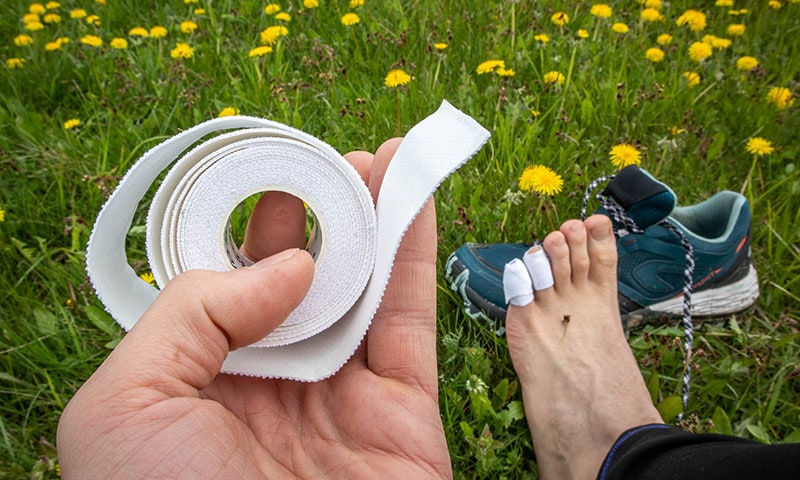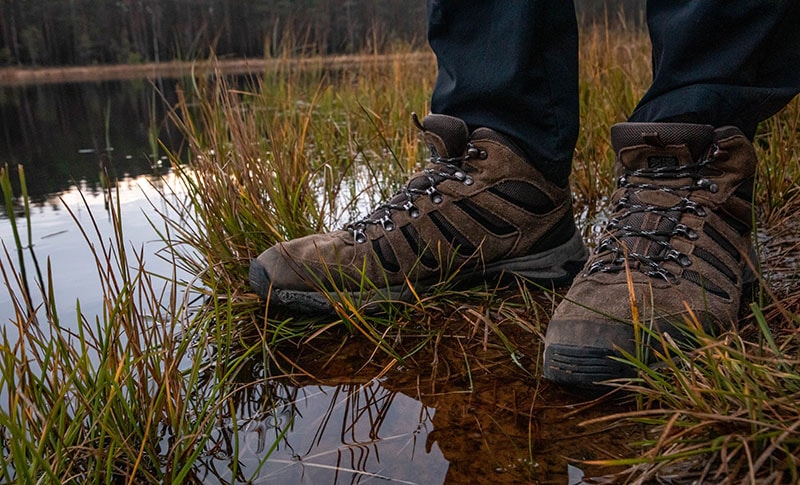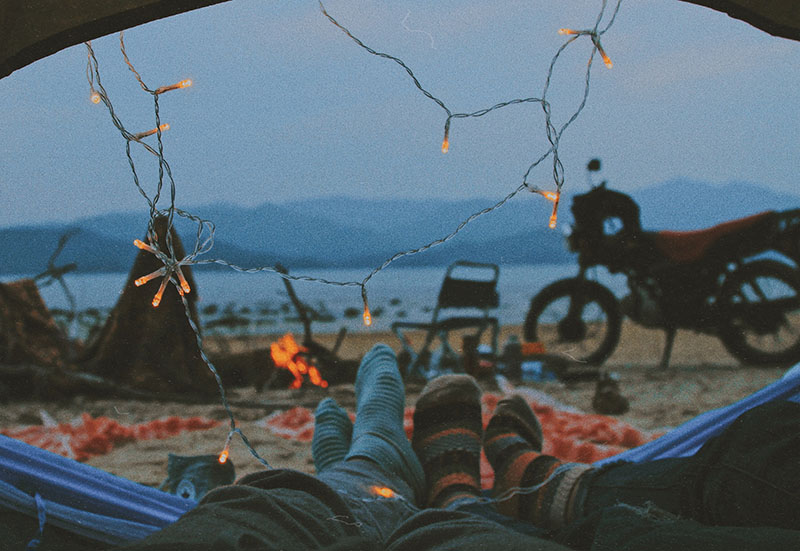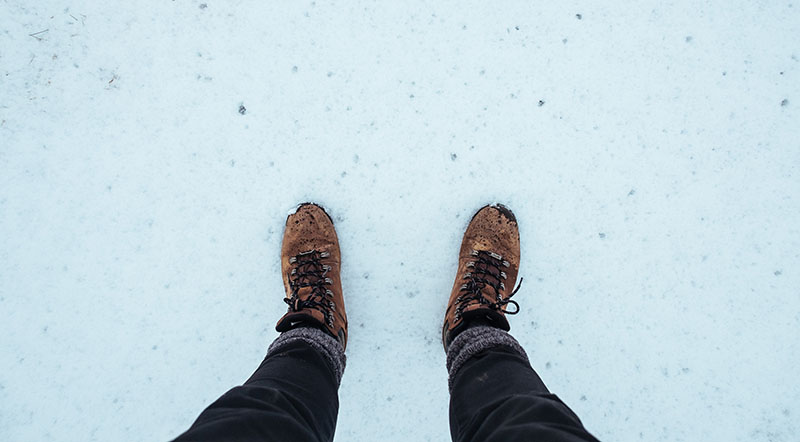Some hikers prefer to hike with two pairs of socks, and others think it’s basically pointless – you can wear just one pair of socks and still end up with zero blisters. I personally did a thru-hike over 800 km (500 miles) with just one pair and I didn’t have any blisters. That said, I still think there’s a place for the two-sock layering system, even nowadays, and I personally would use this system in specific circumstances.
In this article, I’ll make sense of when and where should you wear two pairs of socks when hiking, and share the types of socks that you should use. But before I do that, let’s discuss the pros and cons of wearing two pairs of socks for hiking.
Advantages of Wearing Two Pairs of Socks When Hiking
Blister Prevention

Blisters and calluses form from friction when your feet are rubbing against some kind of fabric – whether it’s a sock or a shoe. With a two-sock system, usually, the first layer fits very tightly, and the second one is used for cushioning. If any rubbing is occurring, it’s happening between the two socks or the outer sock and the shoe, so your feet are protected from blisters.
That said, a lot of modern socks can achieve the same result with just a single layer, you just have to choose the right ones. (Usually, they’re pretty expensive, at least when compared to regular socks.) They do this by implementing a perfect balance of padding, compression, and choosing the right blend of materials.
Read Next: Is It Okay to Hike in Jeans or Should You Buy Hiking Pants?
An Extra Layer of Warmth
I personally wear two pairs of socks when hiking in winter, when it’s below freezing. It’s a well-known strategy by hikers to purchase a warm pair of insulated boots that are 1-2 sizes oversized and compensate for that by wearing two pairs of socks. Even most gear stores and manufacturers will usually recommend this advice. Wearing two pairs of socks just adds an additional layer of insulation, which is very useful in the winter.
An Extra Layer of Padding for Uncomfortable Hiking Shoes
If your hiking shoes or boots are about 1 size too large, you can probably still wear them very comfortably just by wearing two pairs of socks. They might be an even better choice if your footwear feels slightly uncomfortable or if it hasn’t been properly broken in yet. The thicker outer layer of socks will act as an additional layer of cushioning between your shoe and your feet.
Read next: Why Do People Wear Cowbells When Hiking?
Easier to Keep Your Feet Dry

By wearing two layers of socks, you can keep your feet dry fairly easily. If you do a light river crossing or step into a puddle, you can just change the outer layer, which will most likely be wet. And I’ve you’ve been sweating from a rough section on the trail, you can change the inner layer and you’ll be good.
When your feet get wet, you’re much more likely to get blisters. In fact, on my thru-hike, the only time when I felt some discomfort on my feet was after a long day of hiking in rain (and a bit of snow). It didn’t result in blisters, but if it would have continued raining, it probably would have. So I guess the moral of the story is that you should always try to keep your feet dry.
Additional Protection From Bugs and Sharp Plants
If you’re concerned with mosquitoes and bugs, then wearing two layers of long socks will surely help, as the mosquitoes can’t bite through two layers of fabric. This is also really useful when hiking in tick-territory, as it gives a bit of additional protection.
I’ve been hiking in Spain a lot and one thing that usually sticks out (literally) for newcomers is that above a certain altitude, everything becomes sharp and pointy, especially in the southern regions, such as the Sierra Nevada mountain range. Wearing long trousers is too hot for some, so the best combination usually is shorts together with long, thick, tightly-knitted pair of socks, or two pairs of socks. When wearing just one pair, the sharpest plants, and bushes still manage to bite through. (Trust me, I know!)
Read Next: How to Attach Tent to Backpack (To Not Hurt Your Back)
No Need for Additional Sleeping Socks

When you’re wearing two pairs of socks, you can just take off the first or the second layer, depending on how warm the night will be, and you won’t need to bring an additional pair of socks just for sleeping, which will save some weight.
Disadvantages of Wearing Two Pairs of Socks When Hiking
Your Feet Might Get Wet Quicker
When you’re hiking in hot weather, or if the trail is physically demanding, usually two pairs of socks will make your feet sweat much quicker. It might still be manageable, but you’ll have to stop more often to switch to dry pairs while the other ones dry out if you want to avoid blisters. Personally, I wouldn’t wear two pairs of socks if the temperature is above 5-10 C (41-50 F) because my feet would sweat too much. Of course, everyone is different and you might not sweat as much.
Doesn’t Work With Perfectly Sized Shoes
If your shoes are just in the perfect size, there really won’t be room for two pairs of socks. Also, if your feet tend to swell after a long day of hiking, the shoes might become too small for two pairs, and you might have to take one pair out.
Read Next: How to Keep Your Feet From Sliding Forward in Hiking Boots
Extra Weight
Nowadays, every hiker is trying to shave off every gram from their setup wherever they can. I wasn’t a big believer in ultralight hiking before, but after doing a 36-day thru-hike, I’m definitely looking to add more ultralight gear to my setup. And bringing two pairs of socks just won’t cut it when I’m thinking about ditching my pocket knife and lightweight butane stove entirely.
They’ll Start to Smell Bad Quicker
The second layer of socks compromises some breathability, and when you subtract breathability, it’s compensated with sweatiness and stench. Unfortunately, by wearing two pairs of socks, your feet will most definitely start to accumulate unpleasant odors much more quickly. Of course, if the weather is somewhat cold, that most likely won’t happen, because your feet won’t reach the temperature threshold for sweating. Generally, in below-freezing temperatures, from my own experience, stench won’t be a problem when wearing two pairs of socks.
So Should You Hike With Two Pairs of Socks?

Of course, everyone is different, and some might prefer to wear two pairs of socks when hiking on every occasion. But personally, I wouldn’t wear two pairs of socks above 5-10 C (41-50 F), just because they’ll start sweating and developing unpleasant odors much quicker and it’s just extra weight that I’d rather not bring. For summer (and on most other occasions when it’s above freezing) I’d be wearing a single pair of good hiking socks.
But I also like to hike in the winter, when sometimes the temperatures drop down to -20 C / -4 F, and in those instances, I usually wear two pairs of socks. My insulated winter hiking boots are sized for size 45, and my feet are sized for size 44, so I already planned ahead for two pairs of socks when I bought them. Wearing two pairs in winter is better because it provides extra warmth, your feet don’t get damp, and it’s more comfortable.
Read Next: How To Tape Your Feet For Long-Distance Walking
Can You Wear Two Pairs of Regular Socks for Hiking?
Wearing two pairs of random socks for hiking usually isn’t a good idea. First of all, random socks are usually manufactured from cotton, which is a very bad fabric for hiking. And secondly, regular socks don’t have the proper cushioning and compression that’s needed for a double-layer sock system. Wearing two pairs of regular socks will most likely result in blisters and it won’t be comfortable.
What Kind of Socks Should You Use When Hiking With Two Pairs of Socks?
First Layer
In a two-sock system, the inner sock should be thin and compressed. You’re looking for a sock that fits your feet perfectly and it doesn’t move around even a little. There’s a specific hiking term for this – liner socks. You’ll find them in most outdoor gear stores and they’re meant for this exact purpose. A good material for the first layer would be a blend of nylon, polyester, spandex, and wool. A purely synthetic sock without wool would also be a good choice – just don’t go with cotton.
Second Layer
The outer layer should be much thicker and more comfortable. Usually, a good choice for this would be merino wool or regular wool. Some good manufacturers of merino wool socks are Darn Tough and Smartwool. The sock doesn’t have to be purely merino wool, it can also be a blend of merino wool and synthetics (Nylon, polyester, Spandex, e.t.c.). Just make sure that it isn’t made from cotton and that it has plenty of padding and cushioning.
Third Layer
If you’re wearing a third layer of socks (probably because your boots are too large but you want to wear them anyway) they should be very similar to the second layer – thick, padded, and made from wool.
Final Words
Wearing two layers of socks has its advantages and disadvantages. Personally, I think the only viable place for a two-layer sock system is when you’re hiking in winter. The extra cushioning and warmth work wonderfully. Truth be told, my feet were always cold, even with insulated boots, whenever I was hiking in winter before trying out the two-layer system. But that all changed when I bought an oversized pair of boots and compensated for that with an additional layer of socks. That said, I wouldn’t wear two socks above freezing temperatures, just because they sweat much quicker, they develop bad odors, and I don’t want to bring the extra weight.
